Baby Snake With Grey Belly & White Ring Around Neck
Venomous Snakes
Non-Venomous Snakes
Eastern Yellowish-bellied Racer (Coluber constrictor flaviventris)

Eastern Yellow-bellied Racer; David Sledge, 2009; Wikimedia Commons
Color varies—olive, brown, blue with a yellow or cream-colored underside. Young racers accept brown spots that fade as they mature. Grow between 30 and 50 inches. Live in grasslands, brushy areas, prairies, fields, and open woodlands. Racers will occasionally vibrate their tails if alarmed. Diet includes frogs, lizards, rodents, and birds.
Northern Red Snake (Cemohora coccinea copei)

By Glenn Bartolotti – Own piece of work, CC Past-SA iii.0, https://commons.wikimedia.org/w/index.php?curid=26292671
Red saddles bordered by blackness with a large, reddish head and unpatterned white belly. Similar in color and pattern to the red milk snake, but has a red or orangish snout with a white belly. Grows betwixt xiv and twenty inches. Lives underground for most of its life, simply goes above basis to feed on the eggs of other reptiles, rodents, lizards, and small snakes.
Prairie Band-Necked Serpent (Diadophis punctatus arnyi)

Past Psyon – Own work, CC Past-SA 4.0, https://commons.wikimedia.org/due west/index.php?curid=45087526
Dark coloration on the back (dark chocolate-brown, gray, or blue-blackness) with a yellow-orange underbelly and yellow ring around the neck. The abdomen has small blackness spots. Grows betwixt 10 and fourteen inches. Typically lives in rocky, wooded hillsides and seeks shelter under rocks. Diet includes worms, slugs, insects, and pocket-sized salamanders.
Western Worm Ophidian (Carphophis vermis)

By Peter Paplanus – Ain work, CC BY-SA iv.0 https://www.flickr.com/photos/2ndpeter/33569944852
Purple-chocolate-brown coloration with salmon pink underbelly and sides. The tail has a harmless fasten that allows it to move through soil. Grows between 7 and 11 inches. Worm Snakes hide under rocks and logs or burrow into the soil. Lives mainly in wooded hillsides. Diet includes earthworm, insect larvae, and insect eggs.
Earthsnakes
Earthsnakes include the genera Haldea and Virginia and are plant exclusively in the eastern and southeastern United states of america. They have a divided cloacal.
Rough Earthsnake (Haldea straitula)

Past Andrew DuBois CC BY-NC ii.9 https://www.flickr.com/photos/138578145@N04/47766239751/in/photolist-nL6HHg-qDyoin-rAmPTg-22WPaib-2fLWsVM-8EriTZ/
The Rough Earthsnake is on the smaller side, ranging from eighteen-25 cm in length. They are plant in the United States ranging from Virginia to central Texas, including parts of s and southward-primal Missouri. They are a light grey or chocolate-brown color with a pointed head. They have keeled scales and an undivided cloacal. The young of the species are normally darker in color than the adults. The Crude Earthsnake can be found in woodlands and open up areas.
Western Smooth Earthsnake (Virginia valeriae elegans)

By Andrew Hoffman CC BY-NC-ND two.0 https://www.flickr.com/photos/71701055@N00/2689100153/in/photolist-56CkMK-3kWXxq-UB4kH
The Western Smooth Earthsnake tin be found from southern Indiana downwards to central Texas, including much of eastern and primal Missouri. They are18-25 cm in length. These snakes tin range from red to greyish dark-brown with white ventral scales. The scales are keeled.
Ratsnakes
North American and Desert Ratsnakes include the genera Pantherophis and Bogertophis. 1 defining characteristic of these types of snakes is that their cross section is shaped similar a loaf of bread in which the flat belly meets the sides of the ophidian at a distinct angle. They take keeled middorsal scales and a divided cloacal. Some populations of these snakes retain dark blotches from birth, some lose the blotched design over time.
Western Ratsnake ( Pantherophis obsoletus)

By Peter Paplanus- Own Work, CC BY 2.0 https://www.flickr.com/photos/2ndpeter/23931822917/in/photolist-CsLRbv-U2t3rJ-sDjpMt-SRpnhT-cxjrE1-ahV3Mn-sDhYMg-smJHyu-nUrrV9-nUyRpx-nC5fXT-nUgKrR-2g55enC-CPXEu3-9zZw9e-9A3uA3-2g8kxkp-fszy7M/
The Western Ratsnake can exist found ranging from Iowa south to eastern Texas and Louisiana, encompassing all of Missouri. They average 107-183 cm in length. Western Ratsnakes can range from solid colors to a variety of colored patterns. Some Western Ratsnakes are solid black in color, just others can be grey, brown, or slightly xanthous with black, dark-brown, or greyness blotches on the dorsal scales. The ventral scales are usually solid in color and lighter than the dorsal scales. The caput is generally small and absent of blueprint. They are normally plant in rocky hillsides or around abandoned buildings.
Blackness Rat Snake ( Elpahe obsoleta)

By Stephen Lody Photography – Own work http://www.behance.net/kadoka, CC BY-SA 3.0, https://eatables.wikimedia.org/west/index.php?curid=25086856
Usually shiny black in colour, just sometimes has night dark-brown blotches. Underbelly is grey and black. Grows between 42 and 72 inches. Lives in rocky, wooded hillsides, near rivers, or near farms. Able to climb trees and kills their casualty through constriction. Diet includes rodents, birds, and birds' eggs.
Great Plains Rat Snake (Elaphe guttata)
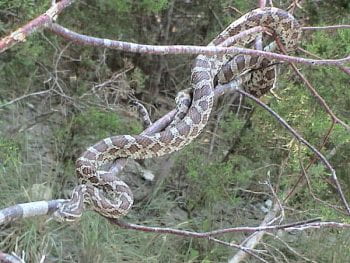
By Dawson at English Wikipedia. – Own work, CC BY-SA 2.v, https://commons.wikimedia.org/w/alphabetize.php?curid=26070126
The Great Plains Rat Ophidian has brownish blotches and distinctive facial markings. Information technology grows betwixt 24 and 36 inches long. Corking Plains Rat Snakes alive in the wooded areas in the southern half of Missouri and along the Missouri River. Their diet consists of rodents, bats, and birds.
Western Mud Ophidian (mutual proper name: hoop ophidian) (Farancia abacura reinwardtii)

By John Sullivan – Own work, CC Past-SA 3.0, https://commons.wikimedia.org/westward/index.php?curid=21703177
This ophidian has a shiny black back with a red, pinkish, and orange abdomen. Its tail ends in a sharp signal. Western Mud Snakes will grown between 40-54 inches. They alive in the southeastern swamps of Missouri. Mud snakes consume three-toed amphiuma, a type of aquatic salamander; tadpoles; and fish.
Western Fox Snake (Elaphe vulpina)
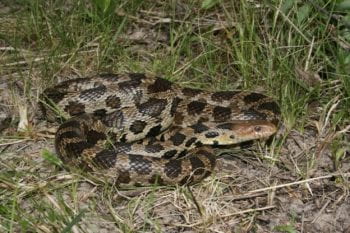
By Don Becker – Ain piece of work, CC By-SA 3.0, https://commons.wikimedia.org/w/index.php?curid=24507539
The Western Play tricks Snake is xanthous, green-brown, or tan with brown blotches and some orange coloring on its head. Its abdomen is xanthous with a blackness checkered pattern. This serpent grows between 36-54 inches. This snake is not very mutual in Missouri, merely it has been found in the Northern third of the state in marshes. Their diet consists of pocket-sized rodents and birds.
Plains Hog-nosed Ophidian (Heterodon nasicus nasicus)

By Peter Paplanus – Own work, CC Past-SA 4.0 https://www.flickr.com/photos/2ndpeter/27232938000
This ophidian is tan or grey with dark brown or grey blotches. Females accept more blotches than males. These snakes differ from Eastern Hog-nosed Snakes considering of their snouts, which are upturned, and the black coloration on the underside of their tails. They grown between sixteen and 25 inches and are very rare in Missouri. They live in loose, sandy soil in prairies and feed on toads, snakes, lizard eggs, and small rodents. They use their upturned snouts to dig for their casualty.
Eastern Hog-nosed Snake (Heterodon platirhinos)
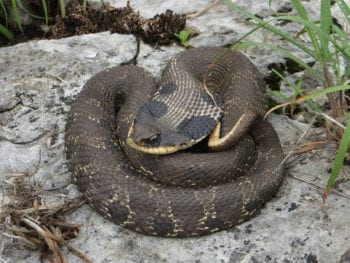
By Psyon – Ain piece of work, CC BY-SA 4.0, https://eatables.wikimedia.org/westward/index.php?curid=45087640
The Eastern Hog-nosed Snake is grey-brown with dark brown markings on its back and a grey belly. It grows betwixt 20-33 inches and lives in sandy areas or open woods. Its diet consists mainly of toads, merely it too eats frogs and salamanders. This serpent is harmless, but tin hiss loudly and spread its neck like a cobra. It will also play dead in cocky defence.
Kingsnakes and Milksnakes
Both part of the genus Lampropeltis, Kingsnakes and Milksnakes accept a big geographical range in North America, ranging from Canada to Montana to Ecuador. These snakes have smooth scales and an undivided cloacal.
Prairie Kingsnake ( Lampopeltis calligaster calligaster)
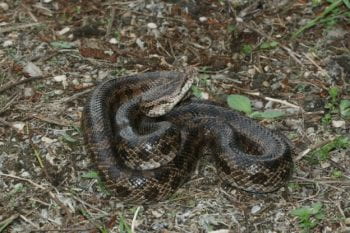
Past Don Becker – Ain work, CC BY-SA iii.0, https://commons.wikimedia.org/westward/index.php?curid=32700947
This common serpent is tan, brown-grey, or green-gray with dark blotches on its dorsum and sides and a xanthous-tan belly with dark markings. Information technology grows between 30 and 42 inches. Its habitat is plant in prairies, woodlands, and rocky hillsides. Kingsnakes can eat other snakes, including venomous species. They are immune to the venom of copperheads, cottonmouths, and rattlesnakes. They also eat lizards, rodents, and birds.
Speckled Kingsnake (Lampropeltis getula holbrooki)

By Peter Paplanus – Own work, CC BY-SA 4.0 https://www.flickr.com/photos/2ndpeter/26289894531
The Speckled Kingsnake is blackness with a white or yellow spot on most scales. Because it looks speckled, it is commonly referred to as the salt and pepper snake. This snake grows between 36 and 48 inches. It lives under rocks and logs in rocky, wooded hillsides. Information technology eats lizards, other snakes, and pocket-size rodents.
Reddish Milk Serpent (Lampropeltis triangulum syspila)

By The original uploader was BillC at English Wikipedia. – Transferred from en.wikipedia to Eatables., CC Past-SA 3.0, https://commons.wikimedia.org/w/index.php?curid=2663201
The Red Milk Snake is white with red or orange markings with black borders. Its abdomen is white with a black checky design. These snakes grown between 21 and 28 inches. They are found statewide in Missouri and live in wooded, rocky hillsides and cedar glades. Its diet consists of lizards, pocket-sized snakes, and mice.
Western Milksnake ( Lampropeltis gentilis)
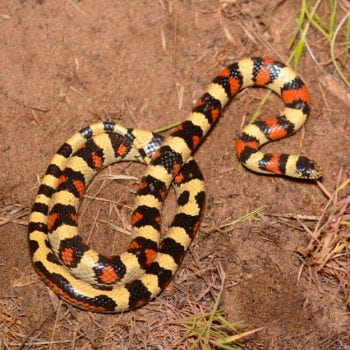
By Andrew DuBois- Ain piece of work, CC BY-NC 2.0 https://world wide web.flickr.com/photos/138578145@N04/27252333406/in/photostream/
The Western Milksnake can be constitute on the western border of Missouri, across the Rocky Mountains, and reaching all the way due north to Montana. They boilerplate 41-76 cm in length. The Western Milksnake is white or cream colour with black-edged reddish or orangish rings found on the unkeeled (shine) dorsal scales. The ventral scales are white or foam colored with scattered black checks. The caput is generally black. Their habitats are varied but many have been institute in grasslands and rocky soils.
Eastern Milksnake (Lampropeltis triangulum)
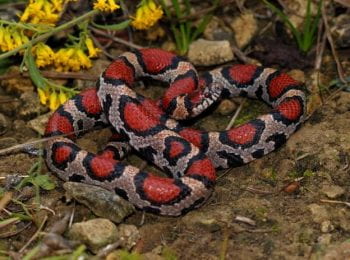
By Peter Paplanus- Ain Work, CC Past 2.0 https://www.flickr.com/photos/2ndpeter/48848367298/in/photolist-2hqyDKh-27YyCKJ-YJ38sn-cETfDm-2g72rEn-24Z1HQ7-67iYxf-utJK8m-rJDP3e-Z6hF6E-ihLjKP-6LTRCe-J7PsFF-p5hnUn-ekEbk9-8Aunmd-26BC7U9-6VmVCv-4JgX52-6yjiXF-aeRUEL-4JmaM5-6Vm1zg-eJsorU-56GuKC-sJWHMP-oqqNu-nFLUuD-7u1KMR
The Eastern Milksnake can be found ranging from southeast Canada and New England across the entire state of Missouri and reaching due south to Louisiana and Alabama. They range in size from 61-90 cm. The Eastern Milksnake can range in colour including grey, tan, or cream with big blackness-edged chocolate-brown middorsal blotches extending down the sides of the snake. The blotches do not extend to the ventral scales. The head has a distinct V shape that connects to the pattern on the rest of the torso. Its habitat includes woodlands, rocky hills, and riverbeds.
Eastern Coachwhip (Mazticophis flagellum flagellum)
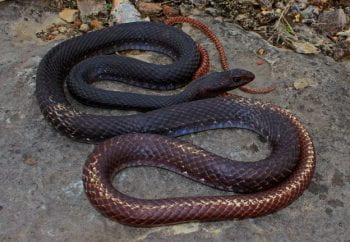
Past Peter Paplanus – https://world wide web.flickr.com/photos/2ndpeter/36423893164/in/dateposted/, CC By two.0, https://eatables.wikimedia.org/west/index.php?curid=62662759
The Eastern Coachwhip is night brown on its forepart half with a tan body and belly. They abound to be very long, averaging 42-lx inches. Eastern Coachwhips live in rocky, wooded hillsides and prairies. Their diet consists of mice, insects, lizards, snakes, and birds. They are found in the southern half of Missouri.
Crude Light-green Snake (Opheodrys aestivus aestivus)

By Asklēpiós – Own work, CC Past-SA four.0, https://commons.wikimedia.org/west/index.php?curid=59548211
This snake is light green with a white belly. It is long and thin with keeled scales. Information technology is 22 to 32 inches in length. Rough Green Snakes live in bushes, vines, or low-hanging branches near bodies of water. It eats soft-bodied insects similar grasshoppers and crickets and is found in the southern half of Missouri.
Polish Green Serpent (Opheodrys vernalis)

By Don Becker – Own piece of work, CC Past-SA 4.0, https://commons.wikimedia.org/west/index.php?curid=40879938
This snake appears very like to the Rough Light-green Snake, just it has smoothen scales instead of keeled scales. It is besides smaller than the Crude Green Serpent, averaging fourteen-20 inches in length. It lives in grassy meadows in northern Missouri, but is endangered due to habitat destruction.
Bullsnake (Pituophis catenifer sayı)

Public Domain, https://eatables.wikimedia.org/w/alphabetize.php?curid=1529601
This snake is tan with brown or black blotches. Its belly is yellow with dark spots along the sides. It ranges in length from 37 to 72 inches. It is found primarily in prairies simply has also been seen in areas near the Ozarks. Information technology eats small mammals, birds, and birds' eggs.
Crayfish Snakes
These snakes include species with genus Regina and can be found in eastern N America. They have by and large pocket-sized heads, xix scale rows, keeled scales and a divided cloacal.
Graham's Crayfish Snake (Regina grahamii)

By Jeromi Hefner – Flickr: Graham'south Crawfish Serpent (Regina grahamii), CC Past 2.0, https://eatables.wikimedia.org/w/alphabetize.php?curid=29704043
The Graham's Crayfish Snake can be constitute from northern Illinois to southeastern Texas, including many parts of northern Missouri. They are 46-71 cm in length. They are distinct in color with blackness or dark brown dorsal scales and a calorie-free-yellow belly, almost looking like an private was split in half. There are narrow blackness stripes where the dorsal scales come across the ventral scales on the sides of the snake. At that place also may exist a pale middorsal stripe running the length of the private. This snake is very reclusive, taking shelter nether rocks or logs in marshes or along streams. Its diet consists mainly of crayfish, and it spends the winter in crayfish burrows.

By Peter Paplanus CC BY 2.0 https://www.flickr.com/photos/2ndpeter/32533152744/in/photolist-2g5QFpA-RyQUSC-rrPbxh-uhSNX1-veSW2T-uXiF9m-vcyPtw-s6Seqf-rRA5jQ-FJKdET-GyhkoX-2hzvq2w-2hzup83-2hzrC6f-FWbRaK-uXreRc-vczn95-67eKeK-uXicHS-uXhPJG-vcyRnm-FJKbev-CQ1fbC-ui3kCk-ui3p36
Footing Snake (Sonora semiannulata)
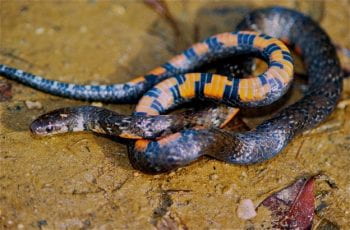
Past Bernard DUPONT from French republic – Short Ground Ophidian (Liophis breviceps), CC BY-SA ii.0, https://commons.wikimedia.org/west/alphabetize.php?curid=40775224
This ophidian varies in colour. It ranges from grey or brown to orange and cherry-red with nighttime bands. Its belly is white or cream with night bands around its tail. It is pocket-size, only growing betwixt 8 and 12 inches. Footing Snakes live in rocky glades and woodlands, where they live under flat rocks. They swallow scorpions, centipedes, and spiders. Ground Snakes are found in the southwestern corner of Missouri.
Flat-headed Ophidian (Tantilla gracilus)
This snake is tan, chocolate-brown, or reddish-dark-brown with a night caput and a pinkish abdomen. It is the smallest snake in Missouri, growing between 7 and 8 inches. Information technology lives under rocks in moist soil, typically on wooded hillsides. It eats centipedes and insect larvae and is found in well-nigh of the southern half of Missouri.
Gartersnakes and Ribbonsnakes
Species of Gartersnakes and Ribbonsnakes are constitute in the genus Thamnophis and can physically exist establish from southern Canada to Costa Rica. They have keeled scales and an undivided cloacal. Nigh species have yellow longitudinal stripes.
Plains Garter Snake (Thamnophis radix)
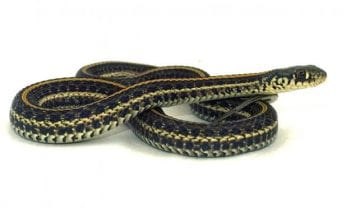
Past Thamnophis – Own piece of work, CC Past-SA 3.0, https://commons.wikimedia.org/west/index.php?curid=6377326
This snake has a yellow strip downwardly its back with blackness spots and bars on its back. It is fifteen-28 inches long and lives in meadows, prairies, marshes, and well-nigh lakes and ponds. Its diet consists of worms, amphibians, and minnows.
Eastern Garter Snake (Thamnophis sirtalis sirtalis)

By D. Gordon E. Robertson – Ain piece of work, CC BY-SA iii.0, https://commons.wikimedia.org/w/index.php?curid=6516547
This common snake ranges in colour from dark brown to olive green. It has three xanthous stripes and xanthous abdomen. It ranges in length from xviii to 26 inches. This snake is found in a wide variety of habitats across eastern Missouri.
Ruby-red-sided Gartersnake ( Thamnophis sirtalis parietalis)

By Andrew DuBois CC BY-NC 2.0 https://world wide web.flickr.com/photos/138578145@N04/30570034633/in/photolist-NRtbsv-NzjMce-NznqfD-PzY1NE-SBMjqa-TE6FtK-ahSo64-ahSnTX-9t2YGt-9XwkmX-an8b8y-dL7JLN-9pXLZQ-9pWjL7-ap3wTd-ecU7d1-9pRKWK-9pUMWd-9pXLXU-9pUKD2-9t5YqA-9pTi8H-9t2NRZ-TXLXVx-7RurZi-84aZgy-847Ubp-cNaadW-bsyvpN-eHo9nr-eHo9bD-BzJYec-S9xwP1-RCuVBL-Sd8PEt-StTPxz-RYxhCS-RCuSYE-bsyyzE-bsywAd-5H4Ww-bFtqsB-6tXziX-Sd9fJM-QYbeBH-QYaNfF-bsyuVU-RYxM6d-Sd9s5H-eHo97p/
The Ruby-red-Sided Gartersnake tin can be constitute from central Canada to Oklahoma, including the northwest corner of Missouri. It is 46-66 cm in length. This species is black, brownish, or olive in color with distinct red or orangish confined on the sides. In improver to these red markings, a lighter middorsal and lateral stripes run down the length of the body. The ventral scales are lighter just can have a few dark spots. They can be found in a large variety of habitats including meadows, marches, alongside streams, and even in more than residential or adult metropolis areas.
Western Ribbon Snake (Thamnophis proximus)
This snake has a light-green belly with black and xanthous stripes down its dorsum. It ranges in length from 20 to 30 inches. The Plains Garter Serpent lives in wooded areas most h2o, feeding on small frogs and minnows. Similar all garter snakes, this snake will emit a strong-smelling musk from the cloaca glands at the base of operations of the tail.
Orange Striped Ribbonsnake (Thamnophis Proximus Proximus)

Past Douglas Mills CC By-NC-ND two.0 https://www.flickr.com/photos/dmills727/186928351/in/photolist-hw4hB-hw4qn-DsRJLZ-bAVPH3-c1tezo-sNRAf5-nwEE8M-nNRzwP-9oJhJp-nwEE6T-51YLED-Uj5Gw-TYTsT-2vpWZj-22WPEpC-21USN4b-5Riqq2-9Emy1u-YRmfZ1-8MmQUx-CHGYh-RPHdDt-8RNB1Z-CHGYg-8Cxf1P-8Cxffe-UATjp-4sCFhL-aBLYhm-CHGYj-CHGYm-tXEp6-CyTUf-4SszT7-ZrZCPN-9Emybu-Fmjqt-o5mcJC-a2Sajv-6ezrvc-6yoDm1-7PfYUX-J98nX7-HRTv8-21RR6R-nPV2bi-o76fMK-nPUik5-nPUjby-nPUgfV/
T
North American Brownsnakes
Species of North American Brownsnakes include genus Storeria and can be institute across North and Fundamental American from Canada to Honduras. Their scales are keeled, cloacal divided and absent-minded loreals.
Dekay's Brownsnake (Storeria dekayi)

By Douglas Mills CC By-NC-ND 2.0 https://www.flickr.com/photos/dmills727/25699001033/in/photolist-gEWMoT-gEWe3x-4dBRF-4Zj6zT-F9W6EH-6Vq6v9-Q2kVgs-9xHme8-X2Yms1-2dZe33V-4Zj6gk-y2pKx7-hw4gF-4Zojew-2fiudQC-FW2FX9-sR7jFX-cPFsLo-2hwAMep-2hwx2bB-2hwzJa4-29aFoNB-24GrzXL-24GrzW3-LJUjNg
This species of Brownsnake tin be found in all states east of the Great Plains, including many parts of southeastern Canada. They can be found across the entire state of Missouri. They range in size from 23-33 cm. This species of Brownsnake can exist a lite-yellowish brown, grey, dark brown, or ruby brown. They have dark downward streaks on the dorsal scales with an unmarked pale yellow or pink belly. They can be found in moist environments including swamps, marshes, parks, or beneath trash.
Northern Red-Bellied Serpent (Storeria occipitomaculata occipitomaculata)

Past Andrew Hoffman CC Past-NC-ND 2.0 https://www.flickr.com/photos/71701055@N00/2773269588/in/photolist-6vkQoQ-5e4JqU-r3yjRt-zPEgmz-5dZo9R-pHDoTm-pzrhmU-pip9Uv-WGHwWQ-29f1DuD-psNakn-6pRLsA-5dZnVi-pzTdZW-JaHDvY-pzTcW3-haReyE-k1XhUJ-k1W6ac-zgmu1z-k1W4SU-haQPie-haQX32-haSyLT-oimjfs-nXSJJJ-ozNZ9q-k1V91e-k1X5t1-k1Wtnu-k1WFxG-k1V2ii-k1U9Qn-k1VvpC-k1TX8e-k1WgqJ-ozQQnX-k1VceR-3xSLiu
The Northern Cerise-Bellied Snake can exist establish from the eastern coast of Canada southwest to the eastern border of Oklahoma, including much of key Missouri. They are 20-25 cm in length. This species has dark-brown dorsal scales and a red belly. This species has well defined nape spots and black areas on the side scales and head. Its habit includes open woods and bogs.
Lined Snake (Tropidoclonion lineatum)

Past Andrew DuBois CC Past-NC 2.0 https://world wide web.flickr.com/photos/138578145@N04/31442683641/in/photolist-PUtYpc-HWPyVt-NRchrM-HN5Nbs-HN5Maj-HWPEyc-H1Yq8y-WoewAE-G2UV3E-egGMHT-dKVbtx-hsbp9-2c4JQs8-2bZkWvS-bTzvtB-bTzvoi-67eKgR-FYmnFZ-bDswXb-53vSQX-73sG4S-bxDAru-vtYLCm-mbdxqW-5boKsF-o55ZGd-96Cvz8-2fz5N8k-HQr1Kx-KMJaJM-2e9kgEZ-H24RPH-HwoibG-nPoKjr-9c3sMW-2e3qVVi-2g3FVgG-bxDwzu-3qpZRE-ao8fkU-4nzWkJ-8nyK59-a4FFdH-xtjfD-2eepQ7e-Tu2Cib-2fCkrfR-2fCkr3r-2fCkqEx-RRTQyT
The Lined Snake can be plant sporadically around parts of Missouri, the Nifty Plains, Texas, and New Mexico. It is 23-38 cm in length. The species is grey or tan with a whitish or yellow middorsal stripe and two lateral stripes. Information technology has keeled scales and an undivided cloacal. They are institute in open areas like prairies or parks.
Water Snakes
Water snakes are non-venomous and live nigh bodies of water. They primarily consume fish and amphibians, but tin also eat small-scale reptiles and rodents. H2o snakes are viviparous, meaning they requite birth to live young. As a self defence mechanism, h2o snakes will emit a strong-smelling musk from the cloaca glands at the base of operations of the tail.
North American Watersnakes
North American Watersnakes are the genus Nerodia and can be constitute in the eastern and key United States. All species accept keeled scales and bear live young. They have a divided cloacal.
Plain Bellied Watersnake (Nerodia erythrogaster)
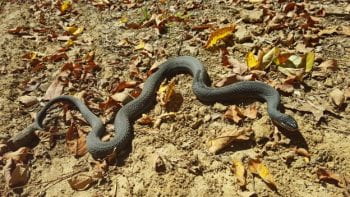
By Andrew DuBois CC-BY-NC 2.0 https://www.flickr.com/photos/138578145@N04/31539155335/in/photolist-24r4YKS-Q41q5g-QcjqLy-P21upB-Qfz8L2-Qfz9e6-QfzaW4-P21veT-Qcjqiu-Qcjssu-P21vGr-P21w6T-4st6d3-hw4rj-2hzrBZo-2hzup2G-6efYKS-hw4vX-2bU4aoH-MscJBF-21hiXzQ-R6Zh3c-i5bBPk-oyQKQ1-nyxP2h-2dbedqj-maaqbh-maamfm-afXhrC-ma9sLt-maanv7-2h61DLm-ma8Md2-ma8KxP-2h5Y77j-2h5ZTFg-2h5Y7et-2h61DqX-2h61Ed8-2h5Y7XN-2h61E4W-2h61DYk-oyQKJ9-c8qdaA-c8qd3U-8CAmPf-ejaWVh-nyxNYS-ejaWUo-97gDfk
The Plain Bellied Watersnake can be constitute ranging as east as Delaware and North Carolina to the southwestern parts of Texas, including parts of southeastern Missouri. They are 76-122 cm long. This species tin be unicolor, slightly patterned, or have a very distinct pattern. Unicolored individuals can exist dark-brown, ruby-red, or greyness. Patterned individuals usually have dark bordered light bands across the dorsal scales retained from youth. The ventral scales are uncolored and lighter than dorsal scales. The Plain Bellied Watersnake can be found in larger bodies of water such every bit rivers, lakes, or swamps.
Midland Watersnake (Nerodia sipedon pleuralis)

By Peter Paplanus CC By 2.0 https://www.flickr.com/photos/2ndpeter/27656451262/in/photolist-wufwu5-J8UxqA-QUMANE-4VFDD1-c2zcBA-c2zbGJ-c2zbZy-c2zbbf-4KBtCw-aSQbTx-aSQbL4-9S2tpE-EBWxw-56GuMb-4KBtFS-UAThx-7ZVaet-cHn6JN-9Y1Adf-9XXG3n-9Y1AeS-9XXG1P-QBTiZ-9XXG5v
The Midland Watersnake can be constitute from Oklahoma to the panhandle of Florida, including the southeastern one-half of Missouri. It is 56-107 cm in length. This species is grey to dark brown with 30 or fewer brown or black dorsal bands with tail markings shaped as rings. It can be constitute in any sea, including fast moving streams.
Mississippi Green H2o Snake ( Nerodia cyclopian)
Greenish-brown with chocolate-brown markings. Its belly is night grey with yellow markings. It grows between 30-45 inches. The Mississippi Green H2o Serpent lives in cypress swamps, and is now endangered in Missouri.
Yellow-bellied Water Snake (Nerodia erythogaster flavigaster)
This snake is greenish-grayness with a yellow belly. It grows between xxx and 48 inches. This snake is found in southeastern Missouri and in the northern Mississippi River floodplain.
Broad-banded H2o Snake (Nerodia fasciata confluens)
This snake is yellow and grey with big brown or black bands. It grows betwixt 22 and 36 inches. They live in the southeastern corner of Missouri.
Diamond-backed Water Snake (Nerodia rhombifer rhombifer)
The Diamond-back is light brown with dark chocolate-brown diamond-shaped markings on its sides and dorsum and a yellow abdomen. They abound between 30 and 48 inches in length. This ophidian is plant in southeastern, northern, and western Missouri, but is not found in the Ozarks.
Northern Water Serpent (Nerodia sipedon sipedon)
This snake is greyness or reddish brown with nighttime brown bands. Its belly is white to light xanthous with black and red markings. The scales on its dorsum are keeled, which ways they have ridges down the middle rather than being polish. This ophidian ranges from 24 to 42 inches in length. The Northern H2o Serpent and its subspecies, the Midland H2o Snake, is institute throughout all of Missouri.
Source: https://sites.wustl.edu/monh/snakes-of-missouri/
0 Response to "Baby Snake With Grey Belly & White Ring Around Neck"
Post a Comment